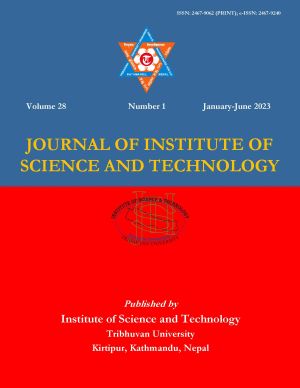Mixing Properties of Cu-Mg Liquid Alloy Using Exponential Model
DOI:
https://doi.org/10.3126/jist.v28i1.54594Keywords:
Cu-Mg alloy, R-K polynomial, surface concentration, surface tensionAbstract
The Redlich-Kister (R-K) polynomial has been generally used to model the mixing properties of binary and higher order alloys. The interaction energy parameters of the R-K polynomial are assumed to be either linear or exponentially temperature-dependent. When these parameters are assumed to be linear temperature-dependent, the computed thermodynamic functions sometimes show unusual trends. But when they are assumed to be exponential temperature-dependent, such trends do not appear in the theoretical calculations. Therefore, the mixing properties of Cu-Mg liquid alloy have been studied using the exponential temperature-dependent parameters of the above-mentioned model. These parameters for excess Gibb’s free energy of mixing have been optimised using the experimental values of enthalpy of mixing and excess entropy of mixing. The study of thermodynamic properties involves the measurement of excess Gibb’s free energy of mixing, enthalpy of mixing and activities of monomers at different temperatures. Likewise, the assessment of surface property includes surface tension and surface concentration. Similarly, the structural properties have been studied by computing concentration fluctuation in long wave-length limit and short-range order parameter at different temperatures. The investigation revealed that the exponential model can explain mixing behavior of Cu-Mg liquid alloy and the system is found to have strong compound forming tendency at its melting temperature. This mixing tendency has been observed to decrease with the increase in temperature above its melting temperature.
Downloads
Downloads
Published
How to Cite
Issue
Section
License
Copyright (c) 2023 Institute of Science and Technology, T.U.

This work is licensed under a Creative Commons Attribution-ShareAlike 4.0 International License.
The views and interpretations in this journal are those of the author(s). They are not attributable to the Institute of Science and Technology, T.U. and do not imply the expression of any opinion concerning the legal status of any country, territory, city, area of its authorities, or concerning the delimitation of its frontiers of boundaries.
The copyright of the articles is held by the Institute of Science and Technology, T.U.




